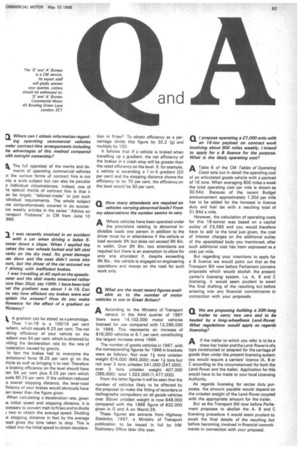2 I was recently involved in an accident with a
Page 65

If you've noticed an error in this article please click here to report it so we can fix it.
car when driving a laden 5turner down a slope. When I applied the rakes the rear wheels locked and left skid 'larks on the dry road. No great damage as done and the case didn't come into ourt, but the driver of the car accused me
f driving with inefficient brakes. • I was travelling at 40 mph on the speedo?star and the skid marks measured rather lore than 30yd, say 100ft. 1 have been told at the gradient was about 1 in 16. Can ou say how efficient my brakes were and Wain the answer? How do you make llowance for the effect of a gradient on Ificiency?
kA gradient can be stated as a percentage.
Thus 1-in-16 is a 100/16 per cent -adient, which equals 6.25 per cent. The net -eking efficiency of your vehicle on the -adient was 54 per cent, which is obtained by viding the deceleration rate by the rate of :.celeration caused by gravity.
In fact the brakes had to overcome the -avitational force (6.25 per cent g) on the thicle as well as bringing it to rest. Therefore le braking efficiency on the level should have :en 54 per cent plus 6.25 per cent which tuals 60.25 per cent. If the collision reduced e overall stopping distance, the level-road ficiency of your brakes would obviously have )en lower than the figure given.
When calculating a deceleration rate, given te initial speed and stopping distance, it is acessary to convert mph to ft/sec and to divide v two to obtain the average speed. Dividing te stopping distance in feet by the average )eed gives the time taken to stop. This is vided into the initial speed to obtain decelera
tion in ft/sec2. To obtain efficiency as a percentage divide this figure by 32.2 (g) and multiply by 100.
It follows that if a vehicle is braked when travelling up a gradient, the net efficiency of the brakes in a crash stop will be greater than the rated efficiency on the level. If, for example, a vehicle is ascending a 1-in-5 gradient (20 per cent) and the stopping distance shows the efficiency to be 70 per cent, the efficiency on the level would be 50 per cent.












































































































